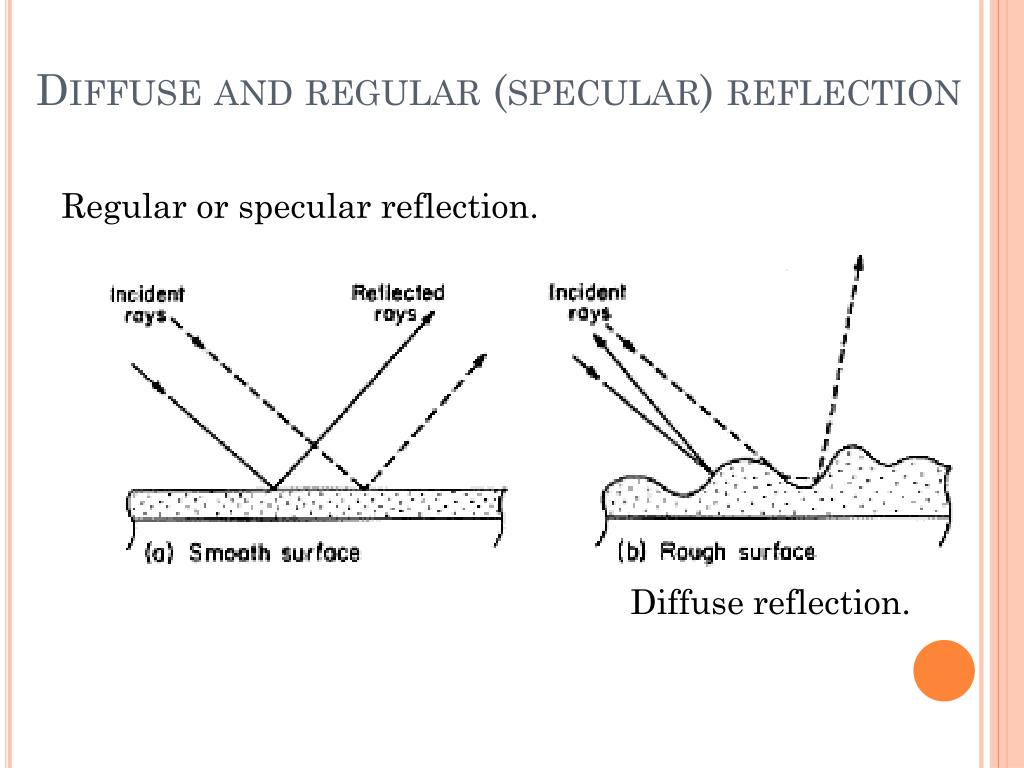
Regular reflection refers to the mirror-like reflection of waves from surfaces, while diffuse reflection refers to the reflection of light or other waves from a surface through the scattering effect.

The following infographic lists the differences between regular and diffuse reflection in tabular form for side by side comparison The key difference between regular and diffuse reflection is that, in regular reflection, the incident ray and the reflected ray have the same single angle of reflection, whereas, in diffuse reflection, there are many scattered reflecting rays having different reflection angles. There are two types of reflection as regular reflection and diffuse reflection, depending on the angle of the reflecting ray. Reflection is the image that we can see on a mirror or a shiny surface.

What is the Difference Between Regular and Diffuse Reflection?

In an ideal diffuse reflection process, we can observe Lambertian reflection (there is equal luminance upon viewing from all the directions that are lying at a half-space that is adjacent to the surface. In contrast, in regular reflection, there is a single angle at which the incident ray reflects. In other words, in diffuse reflection, the waves are reflected from a surface in such a way that the incident ray is scattered at many angles. What is Diffuse Reflection?ĭiffuse reflection refers to the reflection of light or other waves from a surface through the scattering effect. Some examples of regular reflection include visible light on a mirror, radio waves, and microwaves on flying objects, acoustic mirrors (reflects sound) and atomic mirrors (reflect neutral atoms). We can experimentally show the difference between regular reflection and disuse reflection by coating a surface with glossy paint and matte paint the matte paint mainly shows the specular reflection behavior, while the surface with glossy paint mainly shows diffuse reflection. Regular reflection differs from diffuse reflection because, in diffuse reflection, the reflected rays tend to scatter away from the surface.Īccording to the law of reflection, the light that encounters a boundary is affected by the optical and electronic response functions of the material towards the electromagnetic radiation.įigure 02: Specular Reflection from a Wet Metal Sphereĭuring regular reflection, the light reflects and arrives at the same angle. The concept of reflection was first introduced by Hero of Alexander in AD c.10-70. But the incident ray and the reflecting ray are on opposing sides of the surface normal plane, which is the plane that forms from the incident ray and reflecting ray. There is a law of reflection, which describes that a reflected ray of light usually emerges from the reflecting surface at the same angle as the incident ray falling on the mirror. A common example of such a wave is light. Regular reflection or specular reflection refers to the mirror-like reflection of waves from surfaces. Summary – Regular vs Diffuse Reflection What is Regular Reflection? Regular vs Diffuse Reflection in Tabular Formĥ. There are two types of reflection as regular or specular reflection and diffuse reflection, depending on the angle of the reflecting ray. Reflection is the image we can see on a mirror or a shiny surface. The key difference between regular and diffuse reflection is that in regular reflection, the incident ray ( the ray falling on a surface) and the reflected ray ( the ray bouncing back after striking the reflecting surface) have the same single angle of reflection, whereas, in diffuse reflection, there are many scattered reflecting rays having different reflection angles.


 0 kommentar(er)
0 kommentar(er)
